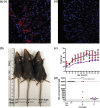Infection Susceptibility in Gastric Intrinsic Factor (Vitamin B12)-Defective Mice Is Subject to Maternal Influences
- PMID: 27329747
- PMCID: PMC4916386
- DOI: 10.1128/mBio.00830-16
Infection Susceptibility in Gastric Intrinsic Factor (Vitamin B12)-Defective Mice Is Subject to Maternal Influences
Abstract
Mice harboring a mutation in the gene encoding gastric intrinsic factor (Gif), a protein essential for the absorption of vitamin B12/cobalamin (Cbl), have potential as a model to explore the role of vitamins in infection. The levels of Cbl in the blood of Gif(tm1a/tm1a) mutant mice were influenced by the maternal genotype, with offspring born to heterozygous (high Cbl, F1) mothers exhibiting a significantly higher serum Cbl level than those born to homozygous (low Cbl, F2) equivalents. Low Cbl levels correlated with susceptibility to an infectious challenge with Salmonella enterica serovar Typhimurium or Citrobacter rodentium, and this susceptibility phenotype was moderated by Cbl administration. Transcriptional and metabolic profiling revealed that Cbl deficient mice exhibited a bioenergetic shift similar to a metabolic phenomenon commonly found in cancerous cells under hypoxic conditions known as the Warburg effect, with this metabolic effect being exacerbated further by infection. Our findings demonstrate a role for Cbl in bacterial infection, with potential general relevance to dietary deficiency and infection susceptibility.
Importance: Malnutrition continues to be a major public health problem in countries with weak infrastructures. In communities with a high prevalence of poor diet, malnourishment and infectious disease can impact vulnerable individuals such as pregnant women and children. Here, we describe a highly flexible murine model for monitoring maternal and environmental influences of vitamin B12 metabolism. We also demonstrate the potential importance of vitamin B12 in controlling susceptibility to bacterial pathogens such as C. rodentium and S Typhimurium. We postulate that this model, along with similarly vitamin deficient mice, could be used to further explore the mechanisms associated with micronutrients and susceptibility to diseases, thereby increasing our understanding of disease in the malnourished.
Copyright © 2016 Mottram et al.
Figures






References
-
- Okoro CK, Kingsley RA, Quail MA, Kankwatira AM, Feasey NA, Parkhill J, Dougan G, Gordon MA. 2012. High-resolution single nucleotide polymorphism analysis distinguishes recrudescence and reinfection in recurrent invasive nontyphoidal Salmonella typhimurium disease. Clin Infect Dis 54:955–963. doi:10.1093/cid/cir1032. - DOI - PMC - PubMed
Publication types
MeSH terms
Grants and funding
LinkOut - more resources
Full Text Sources
Other Literature Sources
Molecular Biology Databases
Miscellaneous
